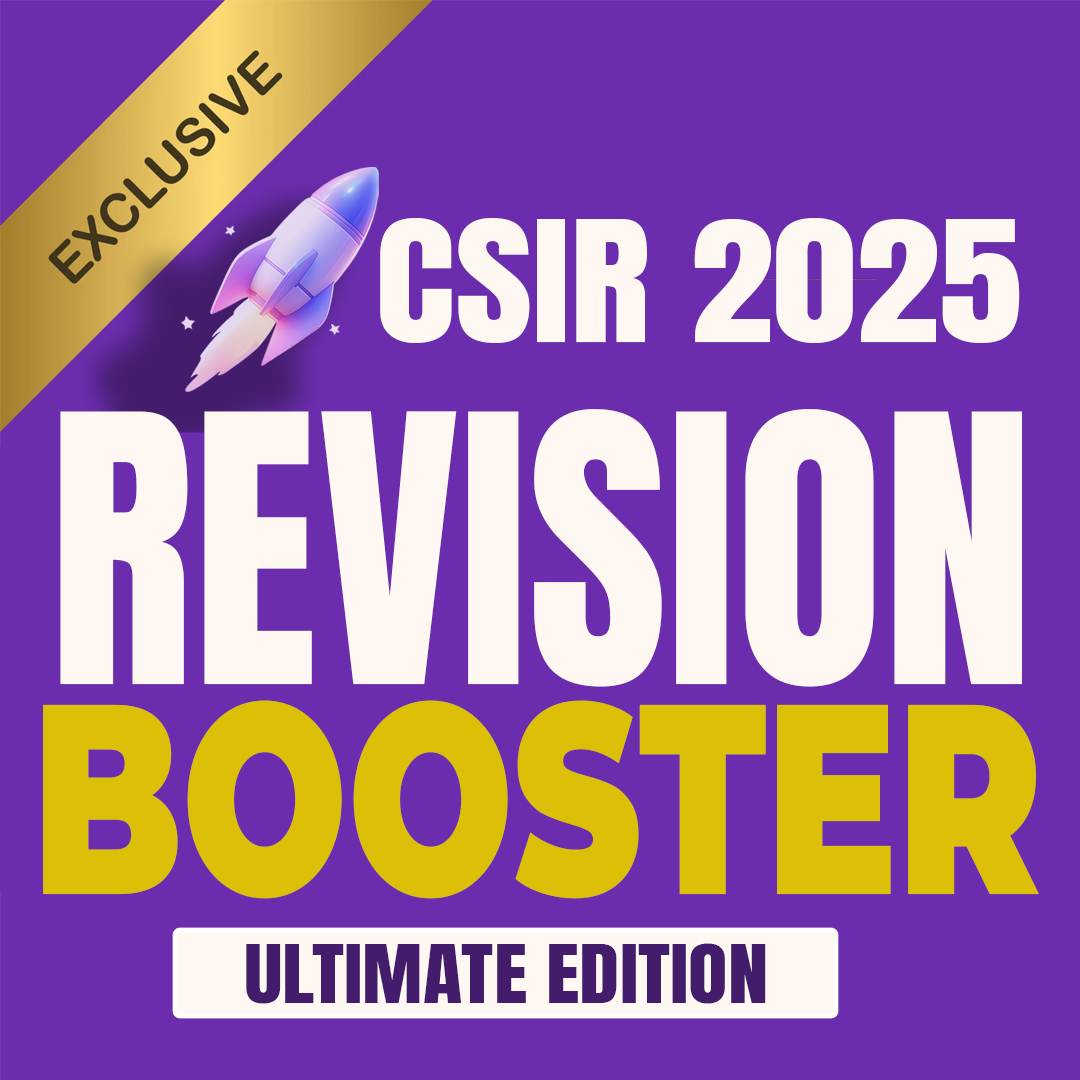Watch Our Free Demo

Ultimate CSIR Life Science Revision Booster - Dec 2025 Edition
A focused revision program crafted to help you excel in the CSIR NET Life Science exam. Please note, this course is specifically designed for last-minute preparation and is not meant for comprehensive, start-to-finish exam preparation. Here's what you'll get:
✅ Complete Syllabus Coverage
Thoroughly revised content spanning all 14 Life Science units, aligned with the latest UGC-CSIR-DBT NET syllabus (Dec 2025 expected pattern).
🎥 14 Hours of Expert-Led Video Sessions
Concise, high-impact video lectures that break down complex topics for quick and effective learning.
📚 In-Depth Study Notes
Unit-wise comprehensive notes to strengthen your understanding and streamline your revision.
🧠 1000+ Practice MCQs with Solutions
Over 32 sets of multiple-choice questions, each with detailed answer keys and explanations to reinforce concepts.
📊 Aptitude Mastery Module
Includes formula sheets and 500 targeted MCQs across 13 modules—built specifically for CSIR aptitude preparation.
🎯 Optimized for Rapid, Focused Preparation
Perfect for final revision, crash courses, or boosting your score during the last leg of your prep.
Pickup currently not available
Expert Opinion
Topics Covered
CSIR Crash Course Overview
==========================
What's Inside:
--------------
1. CSIR Life Science Content
Aligned with the UGC-CSIR-DBT NET updated syllabus
14 hours of video lectures
Study notes for all 14 units covering comprehensive exam content
2. MCQ Practice
1000 MCQs curated into 32 practice sets
Each set includes answer keys with explanations
3. Aptitude Mastery
Formula sheets and explanations for CSIR-specific aptitude topics
500 MCQs across 13 modules plus mixed practice sets
Life Science Content Coverage:
------------------------------
Unit 1: Structure and Function of Biomolecules
1. Introduction
2. Structure of atoms, molecules, and chemical bonds
3. Composition, structure, and function of biomolecules
4. Stabilizing interactions
5. Principles of biophysical chemistry
6. Bioenergetics and metabolism
7. Enzyme and catalysis
8. Conformation of proteins
9. Conformation of nucleic acids
10. Stability of proteins and nucleic acids
11. Metabolism of major biomolecules
Unit 2: Cellular Organisation
1. Introduction
2. Cell wall and membrane: structure and function
3. Intracellular organelles: structure and function
4. Organization of genes and chromosomes
5. Cell division and cell cycle
6. Microbial physiology
Unit 3: Fundamental Processes
1. Introduction
2. DNA replication, repair, and recombination
3. RNA synthesis, processing, and regulation
4. Protein synthesis, processing, and degradation
5. Gene expression control at transcription and translation levels
Unit 4: Cell Communication and Signalling
1. Introduction
2. Cell signalling
3. Cellular communication
4. Innate and adaptive immune system
5. Host-pathogen interaction
6. Cancer
Unit 5: Developmental Biology
1. Introduction
2. Basic concepts of development
3. Gametogenesis, fertilization, and early development
4. Morphogenesis and organogenesis in animals and plants
5. Programmed cell death, aging, and senescence
Unit 6: System Physiology – Plants
1. Introduction
2. Photosynthesis
3. Respiration and photorespiration
4. Nitrogen metabolism
5. Plant hormones
6. Sensory photobiology
7. Solute transport and photoassimilate translocation
8. Secondary metabolites and stress physiology
Unit 7: System Physiology – Animals
1. Introduction
2. Blood and circulation
3. Cardiovascular system
4. Respiratory system
5. Nervous system
6. Sense organs
7. Excretory system
8. Thermoregulation
9. Stress and adaptation
10. Digestive system
11. Endocrinology and reproduction
12. Metaorganisms/holobionts
13. Interorgan communication and energy homeostasis
Unit 8: Inheritance Biology
1. Introduction
2. Chromosomal and extrachromosomal inheritance
3. Genes and mutations
4. Genetic analysis
5. Human genetics
6. Quantitative genetics
7. Chromosomal alterations
Unit 9: Evolution and Diversity of Life Forms
1. Introduction
2. Evolution of life and life forms
3. Principles and methods of taxonomy
4. Microbial life
5. Protists
6. Fungi
7. Plant life
8. Animal life
Unit 10: Ecology and Behavioural Biology
1. Overview
2. Introduction to ecology
3. Population ecology
4. Community ecology
5. Ecosystem ecology
6. Human impacts on ecosystems
7. Biodiversity and conservation
8. Acts and policies
9. Behavioural ecology
Unit 11: Bioinformatics and Computational Biology
1. Introduction
2. Major bioinformatics resources
3. Sequence analysis basics
4. Gene annotation
5. Molecular modelling and dynamics
6. Protein 3D structure comparison
7. Drug design
8. Systems biology
Unit 12: Biochemical Engineering and Industrial Biotechnology
1. Introduction
2. Introductory mathematics
3. Engineering principles
4. Thermodynamics in biological systems
5. Bioprocess engineering and technology
6. Enzymes and microbial technology
7. Downstream processing
8. Bioprocess plant design
9. Metabolic engineering and synthetic biology
Unit 13: Advances in Biotechnology
1. Introduction
2. Recombinant DNA technology
3. Medical biotechnology
4. Animal biotechnology
5. Agricultural biotechnology
6. Marine biotechnology
7. Environmental biotechnology
Unit 14: Methods in Biology
1. Introduction
2. Molecular biology techniques
3. Biophysical methods
4. Omics technologies (genomics, transcriptomics, proteomics, metabolomics)
5. Radiolabelling techniques
6. Histochemical and immunotechniques
7. Microscopy
8. Electrophysiological methods
9. Field biology methods
10. Statistical methods
11. IPR, biosafety, and bioethics
CrashApt – Aptitude Guide Coverage:
-----------------------------------
Includes formula cheat sheets, tips, and 500 MCQs with explanations across:
1. Numbers and divisibility
2. Percentages, profit & loss, SI & CI
3. Ratio, proportion, and mixtures
4. Averages, ages, time, speed, and distance
5. Work and time, pipes and cisterns
6. Permutations, combinations, and probability
7. Data interpretation and basic statistics
8. Series, coding-decoding, analogies
9. Blood relations, directions, and ranking
10. Puzzles (seating, linear, circular, floor)
11. Syllogisms, statements, and conclusions
12. Clock, calendar, cubes, and dice
13. Reading comprehension and critical reasoning

Our courses are carefully designed by subject experts to ensure a step-by-step learning path that builds clarity and confidence in every topic.

We believe quality education should be accessible to everyone. Our pricing is student-friendly, with options that suit every budget.
No deadlines or pressure. Access the course anytime, anywhere, and learn in a way that suits your personal schedule and learning style.
Stay ahead with content that reflects the latest CSIR NET syllabus, question patterns, and exam trends. Every module is aligned with what truly matters in the real exam.
Stay informed with real-time alerts on CSIR NET exam dates, syllabus changes, and important announcements — delivered directly to your dashboard and WhatsApp. Never miss a critical update again!
Get your doubts cleared directly by experts! Our educators host weekly live webinars to answer student queries and provide crystal-clear explanations on tough topics.

About your instructor
I'm a passionate biology educator with experience in mentoring students for competitive exams. I created WhatNext to cut through the clutter and offer exam-focused, time-efficient resources that actually help students succeed. My focus has always been on smart preparation over scattered learning. If you've ever felt lost with too many notes, no clarity and no direction - this is for you!
Shruthi Sridhar, Educator
Frequently Asked Questions
The CSIR NET is a national-level exam conducted to determine eligibility for Junior Research Fellowship (JRF) and Lectureship in Indian universities in the field of Life Sciences.
The exam consists of three parts:
Part A: General Aptitude (common for all)
Part B: Subject-based factual questions
Part C: Analytical, conceptual, and application-based questions
The paper is 3 hours long and carries a total of 200 marks. It is conducted in online (CBT) mode
Yes.
Part A & B: -0.5 for each wrong answer
Part C: -1.0 for each wrong answer
You’ll see 145 questions in the paper, but you need to attempt only:
Part A: 15 out of 20
Part B: 35 out of 50
Part C: 25 out of 75
You must have any one of the following degrees from a recognized Indian institution:
M.Sc. (or equivalent) in Life Sciences
Integrated BS–MS or BS (4-year)
BE / B.Tech
B.Pharma / MBBS
Final-year students in any of the above programs are allowed to apply provisionally—they must complete their degree within the validity period (typically, within 1–2 years after results) to avail fellowship/admission.
The CSIR NET is usually held twice a year — typically in June and December
It varies each cycle but generally lies between 45–55% for JRF and 40–50% for LS, depending on the category.
Yes. The course is curated to target all 14 official CSIR units, focusing on the most expected, high-yield topics for each.
Absolutely. You’ll get module-wise revisions, and mixed tests to simulate the real exam experience.



